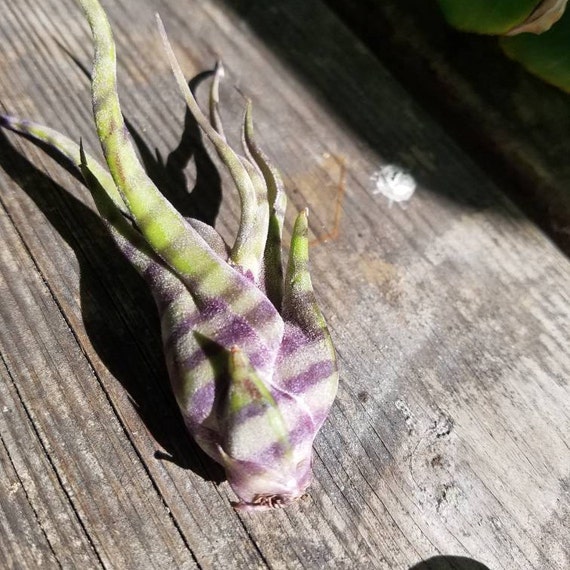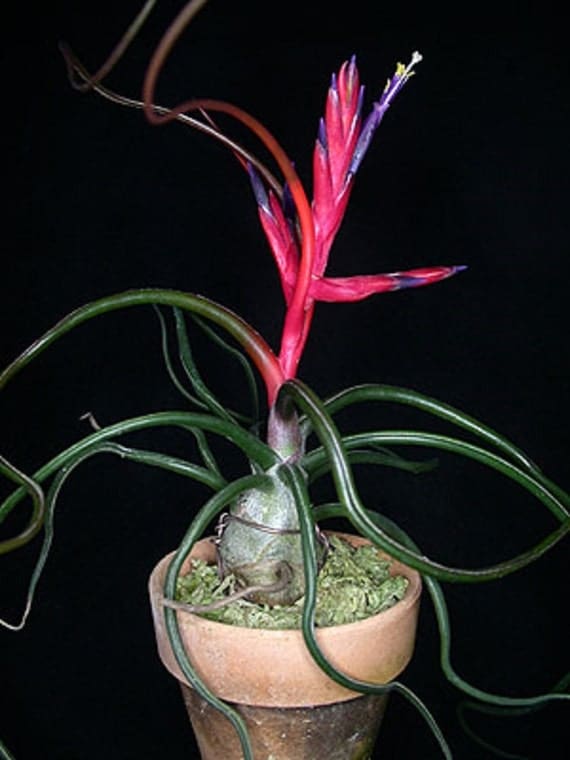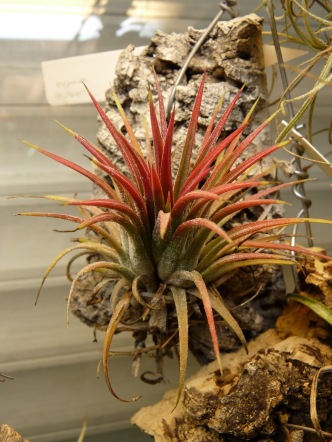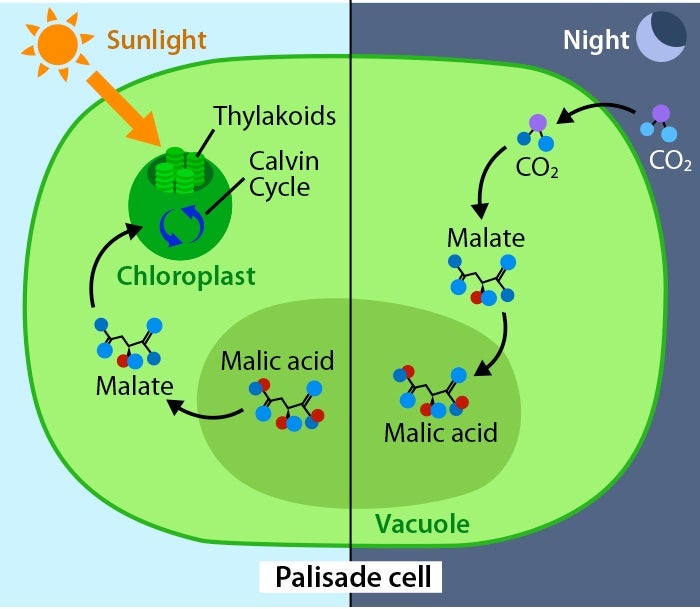
Tillandsia display
Family: Bromeliadaceae
Genus: Tillandsia (Commonly referred to as ‘Air Plants’)
General Characteristics:
Tillandsia’s are Angiosperms in which they produce both flowers and seeds enclosed within a carpel. Additionally, Tillandsia’s are monocotyledon in which their seeds only contain one embryonic leaf (or cotyledon).
Tillandsia are a perennial flowering plant. Additionally, they range in physiology pending the environment in which they are native; thin-leaved plants tend to grow in rainy areas whereas thicker leaved plants are more adapted to arid or dry environments.
Tillandsia’s are considered an epiphytic plant, in which they grow on another plant but not being parasitic to the host plant in which they thrive.
Physiology
Photosynthesis
Species of Tillandsia photosynthesize through the CAM process (See Figure 1) in which they close their stomatal pores during the day in order to prevent water loss and open
them at night to fix carbon dioxide and release oxygen. By closing their pores during the day, they are allowed to regulate water uptake and loss. As you can see at night, the plant absorbs CO2 and converts it to a 4-Carbon molecule which is then stored as Malic Acid in the plants lumen. During the day time, when the stomata are closed, the plants conducts the Calvin Cycle in producing its sugar molecules (Starch). With the coming of darkness, then the cycle repeats itself, releasing oxygen through the stomatal pores and taking in carbon dioxide fur further photosynthesis. [9]
Root system and uptake of nutrients

Image showing Tillandsia root system [15]
Tillandsia’s do not have a functional root system. If any roots exist, they are established to act as only a ‘fragile scaffolding’ to help grip the surface on which they grow. Additionally, due to not having a functional root system, the Tillandsia genus instead absorbs water in small amounts through their leaves via small structures known as trichomes. Also do to the lack of a root system, any nutrients must be absorbed via dust and debris captured in the air. It must also be noted that some species of Tillandsia plants are hollow in the bulbous centers which may serve as a symbiotic relationship with ant colonies; the ants gain a home and the mother plant gains nutrients and fertilizer from the ants.
Origins/Adaptations
The popularity of Tillandsia plants is due to the simple care required to keep these plants alive and thriving. The main thing the Tillandsia plant needs to avoid is frost. Tillandsia plants can flourish in temperatures ranging from 50° Fahrenheit to 90° Fahrenheit. Other than temperature, Tillandsia plants tend to thrive in more arid environments. Tillandsia plants are native to regions that range from South Florida – around the Gulf of Mexico – down Central America – to the Andes mountains in Peru and South America – to the Amazonian rainforest in Brazil – in addition to the West Indian Isles. The plants can be found thriving any where from the swamps of Louisiana to the deserts of Mexico to the mountains of Peru to the rainforests of Brazil. Additionally, Tillandsia species can be found ranging in elevations of 0 meters above sea level to altitudes of 3300 meters in the Andes mountain range.
Reproduction

Tillandsia seed pod split, revealing COMA or Parachute hairs [1]
Tillandsia produce seed and offsets (or pups). The flower must be pollinated in order to form seed pods. Tillandsia seeds are encased in fluffy hairs known as COMA or Parachute. Seeds can take anywhere from 3-months to 2-years to mature, but upon maturation the seed pod will split releasing the seeds. Air plants will release their seeds just before the rainy season, due to the seeds necessity to remain wet during the germination process.

Tillandsia ionantha in bloom [7]
Due to the seeds being parachute-like, the hairs are very course in nature, where they are spread via the wind and are carried away to attach to bark, rocks, or any other surface where the seed can germinate. Regardless of pollination a Tillandsia plant will still produce a pup. Different species of Tillandsia plants can produce anywhere from 1-10 pups;

Tillandsia pup [14]
however, most Tillandsia species only bloom and flower once in their lifetime, therefore, a Tillandsia flower is truly a magnificent flower in hopes of increasing the potential for pollination. [1]
The leaves of the Tillandsia species are unique in which they differ from region to region and species to species. In more humid regions such as the rainforests of Brazil and South America, the leaves tend to be thinner and more flat, whereas in the regions of Mexico and Central America, where the climate is more arid and dry, the leaves tend to have more girth and thickness to combat the limited precipitation conditions. To start, from the bud state of the Tillandsia plant, the leaves are all pinched together near the top to form a bulb or rosette [14]. Upon maturation and growth, the bud will open and splay the leaves out in all directions, (as you will see in the individual plant pictures later).
Pups are simply the fertilized offspring of the mother plant. Unfortunately Tillandsia due to being perennials only flower once and then die. However if fertilized, the seed will form new ‘pups’ which will grow to become adult Tillandsia plants.
Care
According to airplantcity.com, author Jody James describes the simple care procedures necessary to maintain the health of your Tillandsia plant. Tillandsia plants only require a misting of water 2-4 times a week (a water bath possibly if in more arid environment), access to bright filtered light, and avoid frost. Due to the lack of a practical root system, many people display their Tillandsia’s in terrariums where the plant can thrive. Some people even display their Tillandsia plants perched atop a wire (however, caution must be issued to this display, due to if the wire is not coated, the metal may corrode and the plant subsequently may absorb those chemicals. Many people even glue their Tillandsia’s to a piece of drift wood or pottery. The possibilities are endless. One must note, when watering your plant, ensure that you tip the plant over to shake out any excess water that may have accumulated within the plant; any residual water may cause the plant to rot and decay. [2]
Different Tillandsia plants:
Botanical Name: Tillandsia ‘Houston’
Common Name: Houston Dark Pink (also known as Houston Cotton Candy)
Origin: Hybrid of Tillandsia stricta (native of Brazil) and Tillandsia meridionalis (native to Argentina)
Characteristics: Contains a dense spreading rosette that can reach about ~10” in diameter. Leaves are typically medium green in color but may appear whitish near base. Flowers for three to four weeks between December and February. Flower is dark pink in color.

Tillandsia pohliana – Pohliana Purple [3]
Botanical Name: Tillandsia pohliana
Common Name: Pohliana Purple
Origins: Native to Bolivia, Peru, Argentina, Paraguay, and Brazil.
Characteristics: The Pohliana Purple contains long sharp spines that may sometimes bend backward. When flowering, the Pohliana Purple has a large (for its size) inflorescence that produces white and purple flowers. The leaves of the Pohliana Purple curve inward on the edges giving each leaf a triangular shape. The trichomes of the Pohliana Purple appear purple (upon maturation) in nature giving it the ‘purple’ name in addition to having purple flowers.
(Inforescence: An inflorescence is a group or cluster of flowers arranged on a stem that is composed of a main branch or a complicated arrangement of branches. Morphologically, it is the modified part of the shoot of seed plants where flowers are formed)

Tillandsia melanocrater – Tricolor Melanocrater [4]
Common Name: Tricolor Melanocrater
Origins: Native to Mexican and Central American forests.
Characteristics: This plant is called the Tricolor because it changes colors with how much sunlight the plant receives; if the plant receives plentiful sunlight, it will blush deep red to purple colors; but if the plant doesn’t receive as much sunlight it will stay darkish green hued. As the plant matures, it will become more bushy, and just before blooming the leaves will turn dark green or purple. The plant thrives in humidity and heat.

Tillandsia pruinosa – Pruinosa Guatemalan form [13]
Common Name: Pruinosa Guatemalan form
Origins: Native to Florida, Cuba, Mexico, Central and South America. (Commercially cultivated in Guatemala).
Characteristics: This plant is short and fat with an inflorescence that seemingly is very massive compared to its small size. The trichomes on this species are large and silver. The bloom comes off an inflated central spike, that can take on a pinkish hue or remain silver. The flower will be purple in color.

Tillandsia caput-medusae – Caput striped Purple [5]
Common Name: Caput Striped Purple, Madusa’s Head, Octopus plant
Origins: Native to Central America and Mexico.
Characteristics: The trichomes of this species, arrange in a tiger-striped purple pattern, hence the ‘striped purple’ distinction. The plant also receives the term ‘medusae’ because the leaves curve and twist upward giving it the appearance of the mythical Medusa’s head. The leaves can extend up to 10″ tall, and are coated with trichomes that alternate between purple and silver. In greenhouses, the plants will bloom dark red with bright violet flowers from late spring to early summer.

Tillandsia bulbosa – Bulbosa Guatemalan form (in bloom) [6]
Common Name: Bulbosa Guatemalan form
Origins: Native throughout Central America, West Indies, Southern Mexico, and the Northern and Eastern parts of South America.
Characteristics: The leaves of the Bulbosa are very long and slender and give the appearance that they are waving. The base of the Bulbosa is very short and stubby in nature, but may be hollow in the central. Due the plant being hollow, this Tillandsia species is well documented to having a symbiotic relationship with ant colonies, who dwell within the bulb. Where the leaves adjoin at the bulb, the trichomes are often highlighted in a plum color. When the Bulbosa blooms, it will bloom bright red and produce violet petals.

Tillandsia ionantha – Ionantha Orange [7]
Common Name: Ionantha Orange
Origins: Native to Mexico, Costa Rica, and certain areas of South America.
Characteristics: Quite possibly the most popular of all Air-plants. The Tillandsia ionantha has been a hot commodity for air plant collectors and growers recently. The ionantha remains dark green and silver (trichomes) through growth up until maturation and blooming. Upon blooming the leaved trichromes will turn a red/pink/orange color (in this case the Ionantha Orange turns… you guessed it! Orange!) The plant will produce a blue/purple shoot with white or yellow petals.

Tillandsia magnusiana – Magnusiana Pink [8]
Common Name: Magnusiana Pink
Origins: Native to Southern and Western Mexico, Honduras, El Salvador, and Nicaragua.
Characteristics: The Magnusiana Pink grows to about 6-8″ diameter, and produces a relatively short (in comparison to the plant) purple bloom with small purple tubular flowers. The Magnusiana takes on a pincushion like appearance, but the leaves are very soft to the touch. The trichomes may take on a reddish-purple blush if provided with plentiful light. What makes this plant unique from many other Tillandsia species is that it can grow horizontally; as in its base established on a vertical surface.[
Works Cited:
[1] http://www.airplantdesigns.com.au/blog/tillandsia-reproduction-seeds-and-pups/
[2] https://www.airplantcity.com/pages/air-plant-care
[3] http://www.urban-sprouts.com/single-post/2017/10/20/Pohliana-Purple—October-Air-Plant-of-the-Month
[5] https://www.plantopedia.com/tillandsia-caput-medusae/
[8] https://airplantaflor.com/products/magnusiana-enhanced
[9] Borland, A. M., Hartwell, J., Weston, D. J., Schlauch, K. A., Tschaplinski, T. J., Tuskan, G. A., . . . Cushman, J. C. (2014). Engineering crassulacean acid metabolism to improve water-use efficiency. Trends in Plant Science, 19(5), 327-338. 10.1016/j.tplants.2014.01.006 Retrieved from http://www.ncbi.nlm.nih.gov/pubmed/24559590
[10] http://fcbs.org/index1.html
[11] http://www.cell.com/trends/plant-science/fulltext/S1360-1385(14)00021-1
[12] https://www.etsy.com/listing/522176084/air-plant-tillandsia-houston-dark-pink
[13] https://www.tropiflora.com/product/tillandsia-pruinosa/
[14] http://enchantedacorn.com/tag/pups/
[15] http://www.artsnursery.com/blog/growing-tillandsia-air-plants
[16] http://powo.science.kew.org/taxon/urn:lsid:ipni.org:names:125266-1
This page was created by Joseph Talarico


